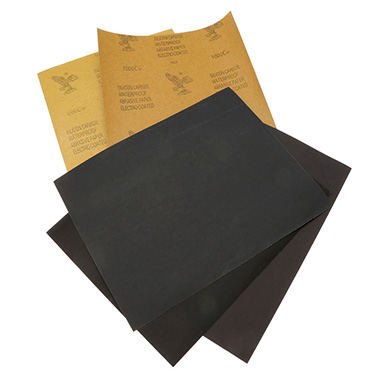Update:
Abrasive paper is a kind of coated abrasive material, mainly for polishing, deburring, sanding and paint removal. It is...
Abrasive paper is a kind of coated abrasive material, mainly for polishing, deburring, sanding and paint removal. It is available in a variety of grit sizes.

This paper is composed of a paper backing on which abrasive grits are applied using a double coat of binder. These abrasive papers have good adhesive power and heat and humidity resistance.
Waterproof Abrasive
Waterproof abrasive, also known as water sandpaper, is a kind of coated abrasive tool made of water-resistant latex paper or waterproof kraft paper and various resins as binders. It firmly adheres aluminum abrasives or silicon carbide abrasives to the substrate and can be processed into sheets of A4 paper size and various customized sizes.
It is a good choice for debarring, polishing, paint removal, corrosion removal and sizing. It is particularly suitable for a variety of materials and applications, such as steel, aluminium, glass, plastics, rubber and ceramics.
It has many advantages over conventional abrasive products, including superior polishing quality and the ability to withstand water ingress. It can be used to sand a wide variety of surfaces and has a very long life. It also has a wide particle size distribution, ranging from P60 to P3000 for products. Its most impressive feature is that it can be used both wet and dry. With these features, it is a very effective and economical product to use.
Abrasive Papers for Wood
Abrasive paper binder for wood, plastics, plaster and metal are abrasive sheets that are coated with grits of aluminium oxide or silicon carbide abrasives. They're used to sand and smooth surfaces, usually for finishing work.
Sanding jobs range from the removal of old paint finishes and rust to rough shaping of wood stock to giving a final, silky-smooth surface. Coated abrasives are available in many different backing materials, abrasive grains and grit sizes to meet specific requirements.
Abrasive papers are made in two styles: closed coat, with the abrasive grairs packed tightly together; and open coat, with grains spaced widely and evenly apart. Closed-coat abrasives cut faster but are more likely to "load up" or clog, which is why they're less suitable for soft substances such as resinous wood or paint.
Abrasive Papers for Metal
Abrasive papers for metal are used in a variety of applications, from sanding bare metal to finishing and polishing polished metal. They can be coated with a variety of abrasives, such as silicon carbide, aluminum oxide, or emery.
Abrasive paper is an important tool for woodworking, metalworking, and other handcrafts. It is also an essential tool for automobile repair, and can be used to remove paint and varnish.
A typical abrasive grit is 100 to 600. The coarser the grit number, the greater the degree of roughness and wear that the abrasive will provide.
For fine work, a grit of 2000 or 3000 can be used. These abrasives are coated with silicon carbide and can be used wet or dry.
Some abrasives have a paper backing and are called paper backed abrasives. These abrasives are lightweight and cost-effective. They also offer even cutting and finer grits for delicate processes. They may be infused with latex to add extra flexibility and durability for specific applications.
Abrasive Papers for Leather
Abrasive paper is an important part of the leathermaking process. It can smooth out scratches and blemishes before dyeing to give your wares a polished appearance. Sandpaper with a good amount of grit is the best choice for this purpose. This abrasive material is also used to smooth plastic trims and dashboards.
Abrasive papers come in a variety of shapes and sizes. They are usually made from a combination of paper and cloth. The most durable abrasives have a mixed base that is coated with a waterproof lubricant. This is a clever way to prevent sand or dirt from clogging the abrasive particles. Other abrasive materials that aren't able to be coated in waterproof varnish may be more difficult to work with. Aside from abrasives, you'll need a good pair of safety goggles and plenty of patience when you're working with this material. It is also a great idea to test the paper out before you use it on your leather.

